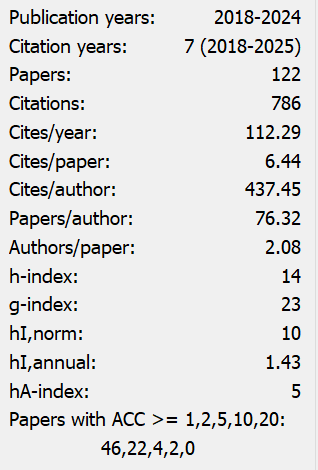Online Shopping in an Emerging Market
The Critical Factors Affecting Customer Purchase Intention in Vietnam
Abstract
The emerging market is currently witnessing the active development of online shopping. This study was conducted to analyze the key factors affecting the intention of customers to purchase in Vietnam. This study is conducted by two methods, including "secondary research method" and "quantitative method" for research. Firstly, the author uses the "secondary research method" to refer to previous academic sources for this research. Secondly, the author collected a sample of 349 volunteers in Vietnam who have an understanding and interest in e-commerce. Perceived Usefulness, Perceived Ease of Use, Perceived Transaction Security are reported to have a positive relationship with online purchase intention. They are significant factors affecting the purchase intention of Vietnamese online customers. Other demographic factors can affect online shopping intention, such as age and income, so research cannot represent all customers. Businesses can use the findings to further understand about emerging markets. This trend is the basis for business managers to develop customer attraction strategies and improve the quality of online shopping services. The potential for online shopping is becoming more attractive, especially in emerging markets. This study is in line with the trend of the online shopping industry. The results of this study can help marketers understand more about customers' intentions, thereby building long-term relationships between businesses and customers.
References
Aineah, B. N. (2016). Factors Influencing Online Purchasing Intention among College Students in Nairobi City (Doctoral dissertation, United States International University-Africa).
Alba, J., Lynch, J., Weitz, B., Janiszewski, C., Lutz, R., Sawyer, A., & Wood, S. (1997). Interactive home shopping: consumer, retailer, and manufacturer incentives to participate in electronic marketplaces. Journal of Marketing, 61(3), 38-53. https://doi.org/10.2307/1251788
Bauer, R. A. (1960). Consumer Behavior as Risk Taking. Conference of the American Marketing Association, 389-398.
Bell, E., & Bryman, A. (2007). The ethics of management research: an exploratory content analysis. British Journal of Management, 18(1), 63-77. https://doi.org/10.1111/j.1467-8551.2006.00487.x
Berry, L. L., Seiders, K., & Grewal, D. (2002). Understanding Service Convenience. Journal of Marketing, 66(3), 1-17. https://doi.org/10.1509/jmkg.66.3.1.18505
Bhimani, A. (1996). Management accounting: European Perspective, Oxford. Oxford University Press.
Broekhuizen, T., & Huizingh, E. K. (2009). Online purchase determinants: Is their effect moderated by direct experience? Management Research News, 32(5), 440-457. https://doi.org/10.1108/01409170910952949
Chau, P. Y. (1996). An Empirical Assessment of a Modified Technology Acceptance Model. Journal of Management Information Systems, 13(2), 185-204. https://doi.org/10.1080/07421222.1996.11518128
Darley, W. K., Blankson, C., & Luethge, D. J. (2010). Toward an integrated framework for online consumer behavior and decision making process: A review. Psychology & Marketing, 27(2), 94-116. https://doi.org/10.1002/mar.20322
Dauda, Y., Santhapparaj, A. S., Asirvatham, D., & Raman, M. (2007). The Impact of E-Commerce Security, and National Environment on Consumer adoption of Internet Banking in Malaysia and Singapore. Journal of Internet Banking & Commerce, 12(2).
Davis, F. (1989). Perceived Usefulness, Perceived Ease of Use & User Acceptance of Information Technology. MIS Quarterly, 13(3), 319-340. https://doi.org/10.2307/249008
Davis, F. D., Bagozzi, R. P., & Warshaw, P. R. (1989). User acceptance of computer technology: A comparison of two theoretical models. Manager Science, 35(8), 982-1003. https://doi.org/10.1287/mnsc.35.8.982
Donthu, N., & Garcia, A. (1999). The internet shopper. Journal of Advertising Research, 39(3), 52-58.
eMarketer (2016). Product/Service Categories Purchased Digitally by Digital Buyers in Urban Vietnam. Retrieved December 29, 2018, from https://www.emarketer.com/Chart/ProductService-Categories-Purchased-Digitally-by-Digital-Buyers-Urban-Vietnam-by-Demographic-July-2016-of-respondents-each-group/195770
eMarketer. (2018a). A Brief Overview of the Global Ecommerce Market. Retrieved December 29, 2018, from https://retail.emarketer.com/article/brief-overview-of-global-ecommerce-market/59690010ebd40005284d5cc5
eMarketer. (2018b). How Do Vietnam's Consumers Shop Online? eMarketer. Retrieved December 29, 2018, from https://www.emarketer.com/Article/How-Do-Vietnams-Consumers-Shop-Online/1014391
Eri, Y., Islam, M. A., & Daud, K. A. K. (2011). Factors that Influence Customers’ Buying Intention on Shopping Online. International Journal of Marketing Studies, 3(1), 128. https://doi.org/10.5539/ijms.v3n1p128
EVBN. (2018). E-COMMERCE INDUSTRY IN VIETNAM REPORT, EDITION 2018. Retrieved January 1, 2018, from https://evbn.org/e-commerce-industry-in-vietnam-report-edition-2018/
Fernandes, C., & Awamleh, R. (2006). Impact of organisational justice in an expatriate work environment. Management Research News, 29(11), 701-712. https://doi.org/10.1108/01409170610716016
Foley, P., & Sutton, D., (1998). Boom time for electronic commerce-rhetoric or reality? Business Horizons, 41(5), 21-31. https://doi.org/10.1016/S0007-6813(98)90074-X
Gong, W., Stump, R. L., & Maddox, L.M. (2013). Factors influencing consumers' online shopping in China. Journal of Asia Business Studies, 7(3), 214-230. https://doi.org/10.1108/JABS-02-2013-0006
Grabner-Kräuter, S., & Faullant, R. (2008). Consumer acceptance of internet banking: the influence of internet trust. International Journal of bank marketing, 26(7), 483-504. https://doi.org/10.1108/02652320810913855
Grandinetti, M. (1996). Establishing and maintaining security on the Internet. Sacramento Business Journal, 13(25), 22.
Gresham, L. G. (2000). Attention, retailers! How convenient is your convenience strategy? MIT Sloan Management Review, 41(3), 79.
Guritno, S., & Siringoringo, H. (2013). Perceived Usefulness, Ease of Use, and Attitude Towards Online Shopping Usefulness Towards Online Airlines Ticket Purchase. Procedia-Social and Behavioral Sciences, 81, 212-216. https://doi.org/10.1016/j.sbspro.2013.06.415
Gitau, L., & Nzuki, D. (2014). Analysis of Determinants of M-Commerce Adoption by Online Consumers. International Journal of Business, Humanities and Technology, 4(3), 88-94.
Ibm.com. (2018). E-commerce Statistics & Technology Trendsetters for 2017 - Ecommerce CRM Software Blog-Ecommerce CRM Software. Retrieved December 26, 2018, from https://www.ibm.com/developerworks/community/blogs/d27b1c65-986e-4a4f-a491-5e8eb23980be/entry/Ecommerce_Statistics_Technology_Trendsetters_for_20171?lang=en
Jiang, L., & Yang, Z. (2013). Measuring consumer perceptions of online shopping convenience. Journal of Service Management, 24(2), 191-214. https://doi.org/10.1108/09564231311323962
Juniwati, J. (2014). Influence of Perceived Usefulness, Ease of Use, Risk on Attitude and Intention to Shop Online. European Journal of Business and Management, 6(27), 218-229.
Lee, E. J., Lee, J., & Eastwood, D. (2003). A two‐step estimation of consumer adoption of technology‐based service innovations. Journal of Consumer Affairs, 37(2), 256-282. https://doi.org/10.1111/j.1745-6606.2003.tb00453.x
Lester, D. H., Forman, A. M., & Loyd, D. (2005). Internet shopping and buying behavior of college students. Services Marketing Quarterly, 27(2), 123-138. https://doi.org/10.1300/J396v27n02_08
Lohse, G. L., & Spiller, P. (1998). Electronic shopping. Communications of ACM, 41(7), 81-87. https://doi.org/10.1145/278476.278491
Nguyen, T. D., & Thang, H. N. (2014). Những cơ hội và thách thức của mua sắm trực tuyến ở Việt Nam. Science magazine – Hong Duc University, 20, 136-144.
Ramayah, T. (2008). Impact of Perceived usefulness, Perceived ease of use and Perceived Enjoyment on Intention to shop online. ICFAI Journal of Systems Management (IJSM), 3(3), 36-51.
Satista (2017a). Number of mobile phone internet users in Vietnam from 2015 to 2022 (in millions). Retrieved December 26, 2018, from https://www.statista.com/statistics/558889/number-of-mobile-internet-user-in-vietnam/
Satista (2017b). Gross domestic product (GDP) per capita in current prices from 2012 to 2022* (in U.S. dollars). Retrieved December 26, 2018, from https://www.statista.com/statistics/444743/gross-domestic- product-gdp-per-capita-in-vietnam/
Saunders, P. (2003). Social theory and the urban question. Routledge.
Shang, J. F., Shen, H. X., & Chen, J. C. (2004). The σ pole in J/ψ→ ωπ+ π−. Physics Letters B, 598(3-4), 149-158. https://doi.org/10.1016/S0370-2693(04)01138-4
Stafford, T. F., Turan, A., & Raisinghani, M. S. (2004). International and Cross- Cultural Influences on Online Shopping Behavior. Journal of Global Information Management, 7(2), 70-87. https://doi.org/10.1080/1097198X.2004.10856373
Susskind, A. (2004). Electronic commerce and world wide web apprehensiveness: An examination of consumers' perceptions of the world wide web. Journal of Computer-Mediated Communication, 9(3). https://doi.org/10.1111/j.1083-6101.2004.tb00287.x
Teck, T. K. (2002). The Impact of Perceived Web Security. Perceived Privacy Loss, Perceived Usefulness and Perceived Ease of Use on the Web-Based Online Transaction Intent, MBA Thesis, School Of Management.
Triandis, H. C. (1980). Reflections on trends in cross-cultural research. Journal of cross-cultural psychology, 11(1), 35-58. https://doi.org/10.1177/0022022180111003
VECITA. (2014). VIETNAM MOBILE E-COMMERCE REPORT 2014. Retrieved December 30, 2018, from http://www.moit.gov.vn/documents/20182/1577125/1508897514331-f7c2601c-17e9-4f2f-b640-1bbfa1c5bcce.pdf?download=true
Venkatesh, V., & Davis, F. D. (2000). A theoretical extension of the technology acceptance model: Four longitudinal field studies. Management Science, 46(2), 186-204. https://doi.org/10.1287/mnsc.46.2.186.11926
Yoon, C. C. (2015). Exploring Factors That Affect Usefulness, Ease Of Use, Trust, And Purchase Intention In The Online Environment. International Journal of Management & Information Systems (Online), 19(1), pp.21.
Yörük, D., Dündar, S., Moga, L. M., & Neculita, M. (2011). Drivers and Attitudes towards Online Shopping: Comparison of Turkey with Romania. Communications of the IBIMA, 2011, 1-12. https://doi.org/10.5171/2011.575361
Yu, C. M., & Abdulai, D. N. (2000). E-commerce and the new economy: The Proceedings of International Conference On Electronic Commerce, Emerging Trends in E-Commerce, Kuala Lumpur, Malaysia, November, Multi Media University.
Zorkadis, V., & Karras, D. A. (2000). Security modeling of electronic commerce infrastructures. In EUROCOMM 2000. Information Systems for Enhanced Public Safety and Security. IEEE/AFCEA, pp. 340-344. https://doi.org/10.1109/EURCOM.2000.874829


This work is licensed under a Creative Commons Attribution 4.0 International License.
Copyright for this article is retained by the author(s), with first publication rights granted to the journal.
This is an open-access article distributed under the terms and conditions of the Creative Commons Attribution license (http://creativecommons.org/licenses/by/4.0/).


























